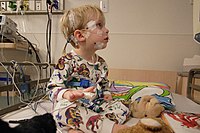
Photo from wikipedia
Several studies suggest that sleep and circadian rhythm disruptions, and physical activity changes may serve as risk factors for the occurrence of Parkinson’s disease and its prodromal features. Obstructive sleep… Click to show full abstract
Several studies suggest that sleep and circadian rhythm disruptions, and physical activity changes may serve as risk factors for the occurrence of Parkinson’s disease and its prodromal features. Obstructive sleep apnea (OSA) is commonly found in patients with RBD. The comorbid OSA is associated with non-motor symptoms, including daytime sleepiness, cogntive decline and autonomic nervous system dysfunction. Therefore, we investigated whether circadian rest-activity patterns and RBD-related symptoms will be improved after positive airway pressure (PAP) therapy in patients who had iRBD with comorbid OSA. Seven patients were diagnosed as iRBD with OSA (AHI ≥ 10) confirmed by video-polysomnography. The patients wore actigraphy devices for 14 consecutive days befor and after PAP therapy for 3 months. The mean motor activity amount (MAA) and the motor activity block (MAB) during sleep were obtained from actigraphic data. Non-parametric circadian rhythm activity including inter-daily stability(IS), intra-daily variability, least 5 average, most 10 average and relative amplitude were anlayzed. In addition, we obtainted the REM sleep behavior disorder questionnaire for the previous 3-month period (RBDQ-3M) and of the Clinical Global Impression-Improvement scale (CGI-I). Four of 7 patients had good compliance of PAP usage (average usage > 4hr during sleep), and three patients had poor compliance of PAP usage. In good compliance group, score of RBD-3M decreased ( p=0.029) and value of IS were increased (p=0.029 ) significantly. Also, 3 of 4 patients answered “Very much improved or much improved” in a questionnaire of CGI. In poor comliance group, there was no any significant change in all values. In addition, only one patient answered “ much imrpoved” and two patients answered “minimally improved” in CGI. The PAP treatment of OSA in iRBD can be role as a lifestyle modifier that improves circadian rest-activity patterns and, it may be of value as a disease-modifying effect of behavioral or lifestyle changes that have been reported to be associated with decreased risk of neurodegenerative disorder. We will continue enroll the data and will investigate not only improvement of circadian rhythm, but also decreasing of motor activities during sleep after PAP therapy.
Journal Title: SLEEP
Year Published: 2023
Link to full text (if available)
Share on Social Media: Sign Up to like & get
recommendations!